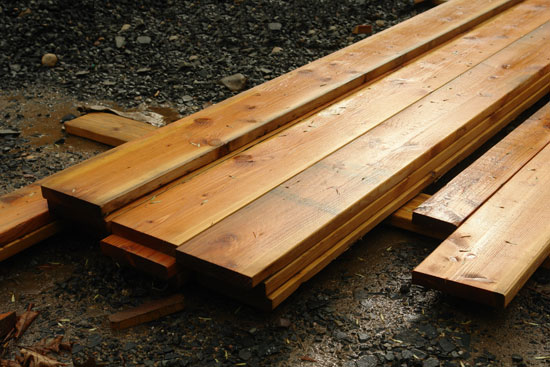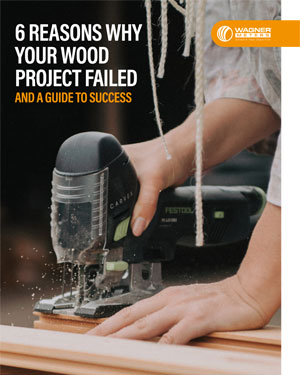Manufacturing and Performance Problems Caused by MC Changes
 Manufacturers of wood products need to pay careful attention to moisture content (MC) to ensure the highest quality and durability of their products.
Manufacturers of wood products need to pay careful attention to moisture content (MC) to ensure the highest quality and durability of their products.
According to Dr. Gene Wengert, Professor Emeritus at the University of Wisconsin-Madison, 75% of all wood manufacturing and quality problems are caused by incorrect MC.
Understanding MC
Wood is a hygroscopic material, which means it easily absorbs or releases moisture. The MC of wood is determined by the moisture in the surrounding air.
Relative humidity (RH) is a way of measuring moisture in the air. It represents the amount of water the air holds compared to the maximum it could hold at a certain temperature and pressure.
As RH increases, wood absorbs moisture and expands. As RH decreases, wood releases moisture to the air and contracts.
The Importance of Controlling MC
Products like wood furniture are made from many parts that must fit together precisely for strength and appearance. Moving parts, such as drawers and cabinet doors, must fit closely, but not so tightly that they bind. Applied finishes can develop cracks if the wood changes too much in size or shape.
Wood expands and contracts with changes in MC, so MC must be carefully controlled. And because RH determines MC, controlling RH is the key to avoiding problems in manufacturing and performance.
This means RH should be kept steady throughout manufacturing and the life of the finished product.
RH and Equilibrium Moisture Content
 As mentioned earlier, when the ambient RH increases, wood will absorb moisture. When the RH decreases, wood will release moisture to the air. When the MC of the wood is in balance with the RH of its environment, this exchange of moisture stops. This condition is called equilibrium, and the MC of the wood at this point is called the equilibrium moisture content (EMC). For every combination of RH and temperature, there’s a specific value of EMC. However, temperature has a very small effect on the EMC.
As mentioned earlier, when the ambient RH increases, wood will absorb moisture. When the RH decreases, wood will release moisture to the air. When the MC of the wood is in balance with the RH of its environment, this exchange of moisture stops. This condition is called equilibrium, and the MC of the wood at this point is called the equilibrium moisture content (EMC). For every combination of RH and temperature, there’s a specific value of EMC. However, temperature has a very small effect on the EMC.
To avoid moisture-related problems, manufacturers of products for interior use should keep wood at an EMC that’s close to the average value for the spaces where the product will be used.
For most air-conditioned offices and homes in North America, the average RH is 30% to 50%. Coastal areas may have RH values as high as 65%. The table below shows the corresponding values for EMC:
RH EMC
30% 6%
50% 9%
65% 12%
A good rule of thumb is that the MC of wood products should not change more than 2% from the time they’re manufactured to the time they reach their final MC in use.
Moisture-Related Problems in Manufacturing
As MC decreases, there is no significant shrinkage along the length of the grain. But wood does shrink by about 1% across the grain as MC decreases by 4% (on average; the magnitude varies by species).
A change in dimension of 1% is enough to cause problems in manufactured wood products. Glue joints can break apart, finishes can crack and wood parts can crack or split.
Because wood shrinks across the grain but shrinks little along the grain, wood parts joined with their grains aligned in different directions can be stressed. Quartersawn and flat sawn wood will also change size at different rates and will be stressed when joined. This can cause warping, cracking and gaps in joints.
MC can also affect wood machining. If the MC is too high, the wood fibers will be weak. This can cause an increase in fuzzing. If MC is too low, the wood can become brittle and can split, crack or chip.
Wood that’s too dry will absorb moisture from glue too rapidly and weaken the glue joint.
If the wood was dried too rapidly, the MC in the center will be higher than on the surface. This causes stress within the wood as the drier outside shrinks more than the wetter center. If the wood is then machined, it releases the stress, and it will immediately warp.
Controlling MC
Freshly cut wood is too wet to be used in manufacturing. So controlling wood moisture must begin before the wood is delivered to the plant.
To speed up the natural drying process, lumber is usually kiln-dried. Kiln drying uses heat and air circulation to dry the wood.
When wood is delivered to the manufacturing plant, the process of precisely controlling the moisture begins. The wood must be kept at the proper MC from the time it’s received to the time it leaves the plant as finished goods.
Any time lumber, wood components or finished goods are stored, the RH of the storage facility must be carefully controlled. Controlling RH is more critical if wood components and parts are stored. Components and parts are smaller than rough lumber so they absorb and give up moisture much faster.
The storage facility should be enclosed and have minimal air leaks to the outside. Humidifiers can add moisture to the air when the RH is too low. Dehumidifiers combined with heat can remove moisture if the RH is too high. In manufacturing areas, RH should be controlled the same way.
Measuring MC
 To accurately control MC, you must be able to measure it accurately. Electronic, hand-held wood moisture meters are widely used to measure MC. The more critical MC is to the wood you’re measuring, the more readings you should take. In a load of lumber, MC can vary widely from piece to piece, so take at least 30 readings for a reliable average. For individual components and parts, take several readings across the surface of the piece. If one reading is far out of range from the others, take another nearby reading.
To accurately control MC, you must be able to measure it accurately. Electronic, hand-held wood moisture meters are widely used to measure MC. The more critical MC is to the wood you’re measuring, the more readings you should take. In a load of lumber, MC can vary widely from piece to piece, so take at least 30 readings for a reliable average. For individual components and parts, take several readings across the surface of the piece. If one reading is far out of range from the others, take another nearby reading.
Also, make certain the meter is properly calibrated per the manufacturer’s instructions.
Types of Moisture Meters
There are two types of moisture meters available: pin meters and pinless meters.
Pin meters use the electrical resistance of moisture in the wood to measure MC. The meter has two metal pins that must be pushed into the wood to the desired depth. The resistance is measured between the pins. Because water conducts electricity, the higher the MC, the lower the resistance.
Pin meters are sensitive to temperature, so they usually come with a temperature correction chart. Also, to obtain accurate moisture readings, pin meters (and pinless meters) must be set for correct species before taking measurements.
To measure at different depths, the user must drive the pins into the wood to the desired depth. The orientation of the wood grain also affects the reading, so the user must drive the pins at the correct orientation.
 Pinless meters use a different approach to measure MC. Instead of measuring resistance, pinless meters send an electromagnetic signal through the wood that measures dielectric properties. The user places the meter on the surface of the wood and the reading is available instantaneously. There are no pins to mar the surface of the wood. There’s no time wasted hammering the pins into the wood, so a pinless meter can be many times faster to use. And there are no pins that can bend or break.
Pinless meters use a different approach to measure MC. Instead of measuring resistance, pinless meters send an electromagnetic signal through the wood that measures dielectric properties. The user places the meter on the surface of the wood and the reading is available instantaneously. There are no pins to mar the surface of the wood. There’s no time wasted hammering the pins into the wood, so a pinless meter can be many times faster to use. And there are no pins that can bend or break.
Pinless meters are sensitive to differences in wood density, so the user must select the correct species setting before taking a reading.
To measure at different depths, a good pinless meter will have a selectable setting. Grain orientation does not affect the readings.
Many professionals prefer pinless meters because of these advantages:
- They don’t mar the wood surface
- They don’t require orienting and driving pins
- There are no pins to bend or break
- They’re unaffected by temperature and grain orientation
- They’re many times faster and easier to use

Free Download – 6 Reasons Your Wood Project Failed
The Wagner Meters Orion® Moisture Meters
The Orion® series of moisture meters from Wagner Meters provide all the benefits of pinless meters and are proven to be among the most accurate in the industry. Orion meters are the only meters available that can be user calibrated in the field in seconds. The Orion 950 offers on-demand RH, temperature, and EMC readings in addition to its standard features.
For more information on wood MC and moisture meters, call us worldwide toll-free (541) 291-5124.
As Sales Manager for Wagner Meters, Ron has more than 35 years of experience with instrumentation and measurement systems in different industries. In previous positions, he has served as Regional Sales Manager, Product and Projects Manager, and Sales Manager for manufacturers involved in measurement instrumentation.
Related Posts via Taxonomies
Last updated on May 4th, 2021



